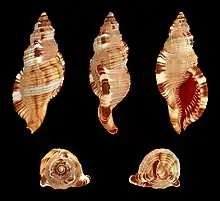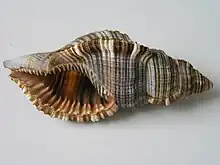Monoplex pilearis
Monoplex pilearis, common name the hairy triton, is a species of medium-sized predatory sea snail, a marine gastropod mollusk in the family Cymatiidae.[1]
| Monoplex pilearis | |
|---|---|
 | |
| A shell of Monoplex pilearis (Linnaeus, 1758) | |
| Scientific classification | |
| Domain: | Eukaryota |
| Kingdom: | Animalia |
| Phylum: | Mollusca |
| Class: | Gastropoda |
| Subclass: | Caenogastropoda |
| Order: | Littorinimorpha |
| Family: | Cymatiidae |
| Genus: | Monoplex |
| Species: | M. pilearis |
| Binomial name | |
| Monoplex pilearis | |
| Synonyms[1] | |
| |
Distribution
This species is widespread in the Atlantic, in the Red Sea and in the Indo-Western Pacific from East and South Africa, to eastern Polynesia, north to southern Japan and Hawaii and south to southern Queensland.[2][3][4][5]
(Monoplex martinianus) This marine species occurs from Florida in the United States to Brazil, Bermudas, Canary Islands, Liberia to Gabon, and Ascension Island.
Habitat
This tropical benthic sea snails can be found at a depth range of 0 – 50 m.[4] They mainly live on hard and coarse detritic bottoms, in coral reef areas.[5]
Description
Shells of Monoplex pilearis can reach a size of 38–140 millimetres (1.5–5.5 in).[2] These large shells are elongate with a tall spire and a strongly inflated body whorl. They show a yellowish-brown surface with chestnut- brown spiral ribs. The columella and the aperture are dark brown with white teeth.[6] The outer sculpture is relatively fine, with long inner ridges of the outer lip, extending deep into the aperture.[5]
Biology
These sea snails are active predators. They are reported as feeding on bivalves. Eggs are laid on the substrate in large capsules clustered in masses.[5]

References
- Monoplex pilearis (Linnaeus, 1758). Retrieved through: World Register of Marine Species on 5 December 2018.
- Hardy's Internet Guide to Marine Gastropods
- Galli C.: WMSDB - Worldwide Mollusc Species Data Base
- Sea Life Base
- Cymatium pileare at FAO.org
- Angeline Myra Keen Sea Shells of Tropical West America: Marine Mollusks from Baja California to Peru
- Gofas, S.; Le Renard, J.; Bouchet, P. (2001). Mollusca. in: Costello, M.J. et al. (eds), European Register of Marine Species: a check-list of the marine species in Europe and a bibliography of guides to their identification. Patrimoines Naturels. 50: 180-213
- Beu, A. (2010). Catalogue of Tonnoidea
External links
- d'Orbigny A. (1841-1853). Mollusques. In: R. de la Sagra (ed.). Histoire physique, politique et naturelle de l'Ile de Cuba. Arthus Bertrand, Paris. Vol 1: 1-264 pp. 1-240, pls 1-10?, 1841; 241-264, 1842; Vol. 2: 1-380 [pp. 1–112, pls 10-21?, 1842; 113-128, 1844; 129-224, pls 22-25?, 1847; 225-380, pls 26-28, 1853]
- Adams, C. B. 1850. Description of supposed new species of marine shells which inhabit Jamaica. Contributions to Conchology, 4: 56-68, 109-123
- Rosenberg, G.; Moretzsohn, F.; García, E. F. (2009). Gastropoda (Mollusca) of the Gulf of Mexico, Pp. 579–699 in: Felder, D.L. and D.K. Camp (eds.), Gulf of Mexico–Origins, Waters, and Biota. Texas A&M Press, College Station, Texas
- Calkins W.W. (1878). Catalogue of the marine shells of Florida, with notes and descriptions of several new species. Proceedings of the Davenport Academy of Natural Sciences. 2: 232-252, 357
- Gastropods.com: Monoplex pilearis